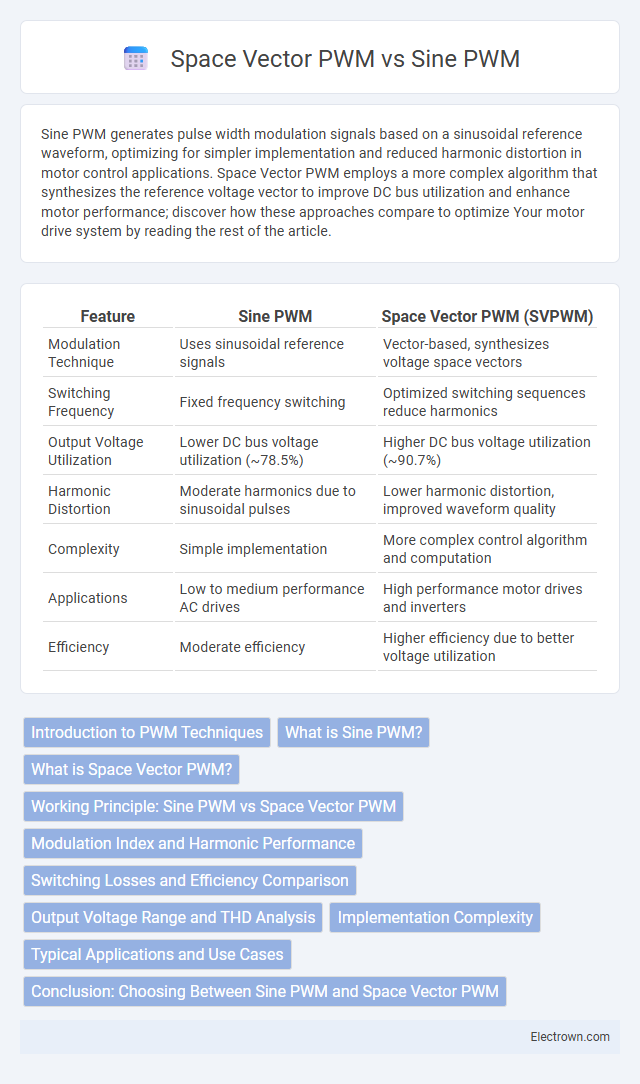Sine PWM generates pulse width modulation signals based on a sinusoidal reference waveform, optimizing for simpler implementation and reduced harmonic distortion in motor control applications. Space Vector PWM employs a more complex algorithm that synthesizes the reference voltage vector to improve DC bus utilization and enhance motor performance; discover how these approaches compare to optimize Your motor drive system by reading the rest of the article.
Table of Comparison
| Feature | Sine PWM | Space Vector PWM (SVPWM) |
|---|---|---|
| Modulation Technique | Uses sinusoidal reference signals | Vector-based, synthesizes voltage space vectors |
| Switching Frequency | Fixed frequency switching | Optimized switching sequences reduce harmonics |
| Output Voltage Utilization | Lower DC bus voltage utilization (~78.5%) | Higher DC bus voltage utilization (~90.7%) |
| Harmonic Distortion | Moderate harmonics due to sinusoidal pulses | Lower harmonic distortion, improved waveform quality |
| Complexity | Simple implementation | More complex control algorithm and computation |
| Applications | Low to medium performance AC drives | High performance motor drives and inverters |
| Efficiency | Moderate efficiency | Higher efficiency due to better voltage utilization |
Introduction to PWM Techniques
Sine PWM generates pulse widths by comparing a sinusoidal reference signal with a high-frequency triangular carrier wave, producing smooth voltage and current waveforms ideal for motor control. Space Vector PWM (SVPWM) calculates optimal switching vectors in a two-dimensional space to maximize DC bus utilization and reduce harmonic distortion. SVPWM achieves higher output voltage and improved efficiency compared to traditional Sine PWM, making it preferable in advanced inverter applications.
What is Sine PWM?
Sine PWM (Pulse Width Modulation) is a technique where the duty cycles of the inverter switches are modulated to approximate a sinusoidal waveform, enabling smooth control of AC motor voltage and frequency. This method uses a reference sine wave compared against a high-frequency carrier signal to generate switching pulses, resulting in reduced harmonic distortion in the output voltage. Your choice of Sine PWM is ideal for applications requiring simple implementation and moderate efficiency in motor drive systems.
What is Space Vector PWM?
Space Vector PWM (SVPWM) is a sophisticated modulation technique used in three-phase inverters to enhance voltage utilization and reduce harmonic distortion. It operates by representing the reference voltage vector in a two-dimensional space and switching between the nearest voltage vectors to synthesize the desired output waveform. SVPWM provides higher DC bus voltage utilization and more efficient motor control compared to traditional Sine PWM methods.
Working Principle: Sine PWM vs Space Vector PWM
Sine PWM generates switching signals by comparing a reference sine wave with a high-frequency carrier triangular wave, producing a sinusoidal output voltage with reduced harmonic distortion. Space Vector PWM uses a space vector representation of the inverter output voltages, selecting optimal voltage vectors to synthesize the reference voltage vector and maximize DC bus utilization. Your choice between Sine PWM and Space Vector PWM impacts inverter efficiency, harmonic performance, and the complexity of the control algorithm.
Modulation Index and Harmonic Performance
Space Vector PWM offers a higher modulation index, typically reaching up to 1.15, compared to the maximum of 1.0 in Sine PWM, enabling better utilization of the DC bus voltage. This results in improved harmonic performance with lower total harmonic distortion (THD) and reduced switching losses in Space Vector PWM. Your choice of Space Vector PWM can lead to enhanced motor efficiency and smoother torque output due to its superior harmonic characteristics.
Switching Losses and Efficiency Comparison
Space Vector PWM typically achieves lower switching losses compared to Sine PWM by optimizing the switching states and reducing the number of transitions per cycle, which directly enhances your system's overall efficiency. Sine PWM generates higher switching frequencies and more frequent transitions, resulting in increased switching losses and reduced efficiency, especially in high-power applications. Choosing Space Vector PWM can improve converter efficiency by minimizing harmonic distortion and enhancing power quality, leading to reduced thermal stress and longer device lifespan.
Output Voltage Range and THD Analysis
Space Vector PWM provides a wider output voltage range compared to Sine PWM by utilizing the full DC bus voltage, enabling better utilization of the inverter's capacity. In terms of total harmonic distortion (THD), Space Vector PWM typically results in lower THD levels due to its optimized switching patterns that minimize harmonic content. This results in improved efficiency and reduced stress on electrical components compared to traditional Sine PWM methods.
Implementation Complexity
Sine PWM offers simpler implementation due to its straightforward sinusoidal reference generation and modulation process, making it suitable for basic inverter control applications. Space Vector PWM involves more complex algorithms that require vector calculations and sector identification, increasing computational demands and implementation complexity. Your choice depends on balancing the ease of implementation with the desired performance and efficiency in motor drive systems.
Typical Applications and Use Cases
Sine PWM is commonly used in applications requiring simple, low-cost motor control, such as household appliances and basic industrial drives, where smooth torque and minimal harmonic distortion are necessary but advanced performance is not critical. Space Vector PWM offers superior efficiency and precision in high-performance drives, electric vehicles, and renewable energy inverters by providing better utilization of the DC bus voltage and reduced switching losses. Your choice depends on balancing cost and complexity with the need for optimized motor control and power quality.
Conclusion: Choosing Between Sine PWM and Space Vector PWM
Choosing between Sine PWM and Space Vector PWM depends on your application's performance requirements and complexity tolerance. Sine PWM offers simpler implementation with good harmonic performance, suitable for less demanding systems, while Space Vector PWM provides superior voltage utilization and lower harmonic distortion, ideal for high-performance drives. Your decision should balance these factors against hardware capabilities and control precision needs.
Sine PWM vs Space Vector PWM Infographic

 electrown.com
electrown.com